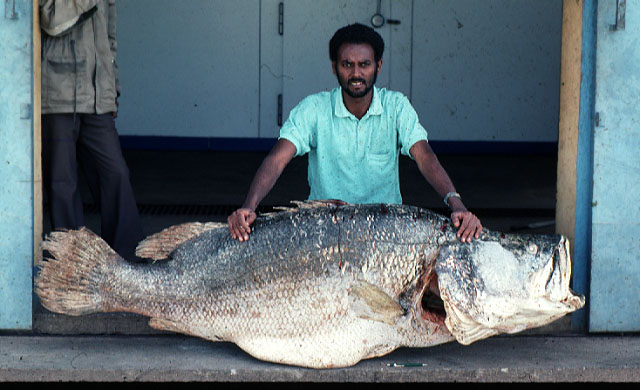| Latidae (Lates perches) |
| 200 cm TL (male/unsexed); max.weight: 200 kg |
|
demersal; freshwater; depth range 10 - 60 m, potamodromous |
| Africa: widespread throughout the Nilo-Sudan region of Africa, occurring commonly in all major river basins including Senegal, Niger, Volta, Chad (Ref. 81285, 81652) and Nile (Ref. 3636, 28714, 81652). Found almost everywhere in West Africa, except in Gambia (Ref. 81285). Also present in the Congo basin and lakes Albert, Turkana/Rudolph and Tana (Ref. 3636). Several countries report adverse ecological impact after introduction. |
|
Dorsal spines (total): 7-8; Dorsal soft rays (total): 8-14; Anal spines: 3-3; Anal soft rays: 7-9. Diagnosis: mouth large and protrusible (Ref. 28714, 81285, 81652), lower jaw (slightly) prominent (Ref. 81285, 81652). Numerous villiform teeth present in jaws, on palate (Ref. 81285, 81652) and vomer (Ref. 81652). Preorbital/lachrymal (Ref. 4967, 81652) and preopercle (Ref. 4967, 81285, 81652) denticulate. Strong, prominent opercular spine present (Ref. 4967, 81285, 81652) on free edge of opercle, and a smaller one dorsal to it (Ref. 81652). Dorsal fin divided by a deep notch into anterior spiny and posterior soft-rayed sections; anal fin with 3 spines; pelvics with a spine and situated close to the pectorals (Ref. 28714). Caudal fin rounded (Ref. 4967, 81285, 81652). Scales ctenoid, 54-74 along lateral line, followed by 6-8 pored scales on caudal-fin base; ceratobranchial (lower limb) of first gill arch with 12-14 gill rakers (Ref. 81285).
Coloration: body uniformly silvery (Ref. 81285) or dark greyish-blue dorsally, greyish-silver on flank and ventrally (Ref. 34290, 81652). Fins greyish; interior of eye conspicuously yellowish (Ref. 81285). Juveniles brownish with lighter marbling (Ref. 81285) on head and flanks (Ref. 81652). |
| Inhabits channels, lakes and irrigation canals (Ref. 28714, 81652). Adults inhabit deep water, while juveniles are found in shallow water (Ref. 81652). Feeds on fish especially clupeids and Alestes (Ref. 13851). Smaller fish also feed on larger crustaceans and insects; juveniles are planktivorous (Ref. 28714). Threatened due to over harvesting (Ref. 58490). No length type given but assumed to be in TL. Maximum reported size of 180.0 cm corresponding to a weight of 164 kg in Lake Albert (Ref. 81285). |
|
Least Concern (LC); Date assessed: 15 May 2019 Ref. (130435)
|
| potential pest |
|
Known from Lake Turkana (Refs. 13364, 52331 and 52871). It was introduced in Lake Victoria in the late 1950s and early 1960s from the shallow waters of Lake Albert and Lake Turkana (Ref. 52331). Introduced in Lake Victoria to feed on abundant but unexploited small size haplochromines, to convert them into larger table fish (Ref. 7270). The introduction virtually eliminated numerous unique cichlids in the area and has been the subject of many debates (Ref. 1739). An unpublished introduction took place in Lake Naivasha in the early 1970s, and since the early 1980s several perch have been caught; there is no information available as to its present status but probably the species did not establish in the lake (Ref. 52331). Apparently the species has not established in the Tana River after it escaped from Sagana Fish Culture Farm into the middle Tana River after exceptional floods at the end of 1961 (Ref. 52331). Also Ref. 13364. |
Source and more info: www.fishbase.org. For personal, classroom, and other internal use only. Not for publication.

